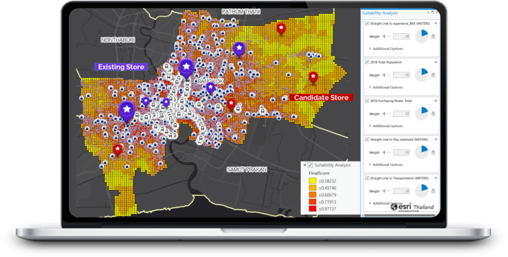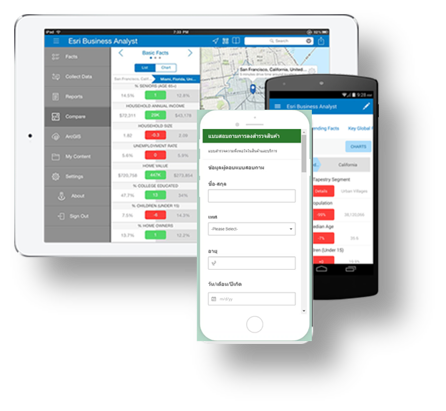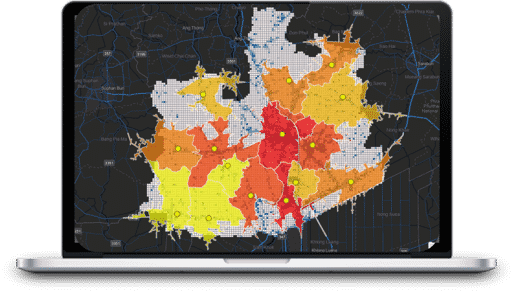In the age of digital transformation, the Geographic Information System (GIS) plays a crucial role in the use of location-based analytics to open up a fresh perspective on space usage. The technology enhances data analytic capacity, enabling an in-depth understanding which not only complements a decision-making process but also allows forecast. Data are the key. These include data about the population, business, sales, profit, consumer behaviour, competitors or background information. They are all factors that can have an effect on the business.
The ArcGIS platform is distinguished by its location intelligence capacity. The software is capable of producing analytical results that allow users to understand data characters starting from data collection, analysis and sharing to how the data are accessed and an efficient, real-time data integration. The solution works with various types of business be they retail, property, logistics, utilities and many others.
Location Intelligence for Business
4 Solutions to Meet Business Needs

Market planning and site analytics
Data analytics especially through an analysis of target groups are instrumental for an effective market planning.
The solution works by collecting data that match the target group’s interest such as ages, purchasing power for certain products and income bases in each area. The data are then analysed and overlaid on a map. The graphic visual will show which area is equipped with features that correspond to the target group’s interest.The solution is also effective in identifying an appropriate location for branch opening/closing. It relies on a weighted scoring calculation using such criteria as the customer’s location, household, access to the branch, rivals’ locations, among others.
Field market data collection
An effective database that is also relevant to target groups is crucial for a business to build a competitive advantage. The ArcGIS system is equipped with tools suitable for field surveys of market data. The information provides an insight into consumer behaviour and needs of certain products in different areas. It also reveals what factors may affect sales and can be used to support marketing activities. The software can collect the location of surveyed groups which can be used as samples of population in other analyses. It runs on both smart phones, tablets and iPad.


Zone planning
Enhance your service with trade area analysis. For this function, the trade area can be designated based on the distance or time. The system provides spatial analysis of areas around the shop or service area. It can show the number of competitors in the area.
It comes complete with a gap analysis, searching for areas that have not been covered by the sales and services. Moreover, it can do a territory design dividing an area into units where each member of the sales team will have the same number of customers. It can also specify an appropriate distance to a branch for a more effective sales management.
Data exploratory analysis
An in-depth data analysis that shows relations among data points can produce precise prediction. The Data Exploratory Analysis (DEA) can combine location-based data with business-related information to come up with a feasibility analysis for the opening of new future market. The method provides new ways to look at data sets such as through the distribution or clustering of customers at a certain period of time or relations between sales volume and outlet location. It can delve deep and find statistical connections such as analyzing year-to-date types of products and sales volume together to predict the amount of sales at select locations or to determine which area may have a favourable potential.

In the age of digital transformation, the Geographic Information System (GIS) plays a crucial role in the use of location-based analytics to open up a fresh perspective on space usage. The technology enhances data analytic capacity, enabling an in-depth understanding which not only complements a decision-making process but also allows forecast. Data are the key. These include data about the population, business, sales, profit, consumer behaviour, competitors or background information. They are all factors that can have an effect on the business.
The ArcGIS platform is distinguished by its location intelligence capacity. The software is capable of producing analytical results that allow users to understand data characters starting from data collection, analysis and sharing to how the data are accessed and an efficient, real-time data integration. The solution works with various types of business be they retail, property, logistics, utilities and many others.
Location Intelligence for Business
4 Solutions to Meet Business Needs

Market planning and site analytics
Data analytics especially through an analysis of target groups are instrumental for an effective market planning.
The solution works by collecting data that match the target group’s interest such as ages, purchasing power for certain products and income bases in each area. The data are then analysed and overlaid on a map. The graphic visual will show which area is equipped with features that correspond to the target group’s interest.The solution is also effective in identifying an appropriate location for branch opening/closing. It relies on a weighted scoring calculation using such criteria as the customer’s location, household, access to the branch, rivals’ locations, among others.

Field market data collection
An effective database that is also relevant to target groups is crucial for a business to build a competitive advantage. The ArcGIS system is equipped with tools suitable for field surveys of market data. The information provides an insight into consumer behaviour and needs of certain products in different areas. It also reveals what factors may affect sales and can be used to support marketing activities. The software can collect the location of surveyed groups which can be used as samples of population in other analyses. It runs on both smart phones, tablets and iPad.

Zone planning
Enhance your service with trade area analysis. For this function, the trade area can be designated based on the distance or time. The system provides spatial analysis of areas around the shop or service area. It can show the number of competitors in the area.
It comes complete with a gap analysis, searching for areas that have not been covered by the sales and services. Moreover, it can do a territory design dividing an area into units where each member of the sales team will have the same number of customers. It can also specify an appropriate distance to a branch for a more effective sales management.

Data exploratory analysis
An in-depth data analysis that shows relations among data points can produce precise prediction. The Data Exploratory Analysis (DEA) can combine location-based data with business-related information to come up with a feasibility analysis for the opening of new future market. The method provides new ways to look at data sets such as through the distribution or clustering of customers at a certain period of time or relations between sales volume and outlet location. It can delve deep and find statistical connections such as analyzing year-to-date types of products and sales volume together to predict the amount of sales at select locations or to determine which area may have a favourable potential.
